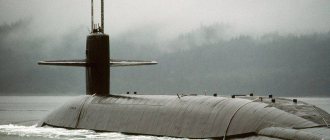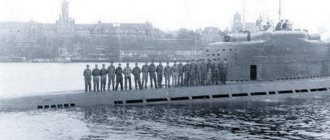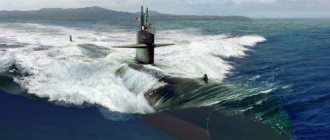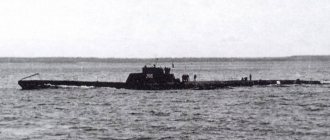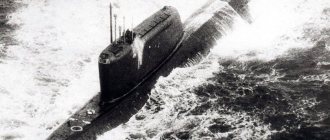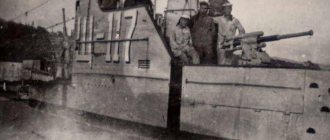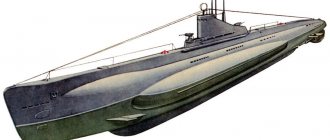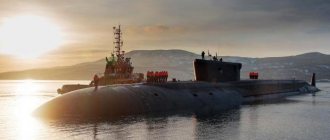Design
Frame
Power point
British submarines run on weapons-grade uranium.
Other equipment
- Sonar:
Marconi/Plessey Type 2054 has three antennas with different frequencies; towed low-frequency sonar (type 2046), body-mounted sonar (type 2043) performs both passive and active search. - Locator/Radar:
1 Kelvin Hughes Type 1007, 1 Dowly Sema SMCS - Fire control systems:
1 Dowty tactical control system SAFS 3 FCS - Countermeasures:
2 x SSE Mk 10 Launchers for Type 2066 and 2071 decoys ESM; Racal UAP 3 - Periscope:
search SK51 and combat SN91, manufactured, equipped with video cameras and thermal imagers.
In December 2008, the boats were equipped with the Submarine Command System Next Generation (SMCS NG) combat information and control systems. SMCS NG is based on multifunctional computer terminals with a special operating system based on Windows XP, which is projected to reduce the cost of maintaining on-board systems by more than £2 million per year.
Crew accommodation
Armament
Sixteen American-made Trident-2 D5 ballistic missiles are installed in 16 Mk14 launch silos. Launch shafts, which are part of a robust body, provide reliable storage, maintenance and protection from overloads and external environmental influences. The top of the housing is closed with a dome-shaped superstructure, which protects the shaft from seawater entering when the lid is opened. The rocket, weighing 57.5 tons, reaches the surface of the water using a steam-gas mixture. The rocket can be launched from a depth of up to 30 meters and after uncontrolled movement in the water column, the rocket, based on a signal from the acceleration sensor, turns on the first stage propulsion engine. The launch shaft cover automatically closes, and the water that gets into the launch cup is drained into a special replacement tank.
The Mark 6's inertial control system, which uses star orientation to control the missile, does not allow it to deviate from its intended target by more than 120 meters. The missile fire control system makes it possible to retarget missiles located in launchers to newly designated targets, both according to a pre-prepared flight program, and directly calculated on board the boat using the transmitted target coordinates. To do this, it is possible to use two main computers and a network of peripheral small-sized computers. The missile firing control panel is installed in the central command post. British Trident-2 D5 missiles differ from those installed on American Ohio-class boats. They can carry eight British-designed warheads with a capacity of 150 kt each and are almost 50 cm longer.
In the bow torpedo compartment there are four 533-mm tubes designed for launching Tigerfish and Spearfish torpedoes manufactured by . Tigerfish is a wire-guided torpedo with a 134 kg warhead, with an active range of 13 km and a passive range of 29 km. The Spearfish's maximum combat range reaches sixty-five kilometers.
Design
Power point
The PWR-2 nuclear reactor, powered by weapons-grade uranium, was developed especially for submarines of this class. Two steam turbines with a capacity of 27,500 horsepower transmit energy to a single water-jet propulsion unit. Two turbogenerators provide the boat with electricity. In case of failure of the main power plant, two diesel generators with a capacity of 2,700 horsepower are provided.
Crew accommodation
The regular crew of the Vanguard class submarine consists of 135 people. For personnel, wardrooms are equipped, combining a dining room, an assembly hall and rest rooms. Crew members, together with the service, can improve their education, for which there is a large library on the boat. A distinctive feature of the Vanguard class nuclear submarine is that it provides crew members with the highest possible comfort, which makes it easier to endure long (up to 3 months) voyages in the North Atlantic and the Norwegian Sea.
Other equipment
In December 2008, the boats were equipped with the Submarine Command System Next Generation (SMCS NG) combat information and control systems. SMCS NG is based on multifunctional computer terminals with a special operating system based on Windows XP, which is predicted to reduce the cost of maintaining on-board systems by more than £2 million per year.
Arabic Bulgarian Chinese Croatian Czech Danish Dutch English Estonian Finnish French German Greek Hebrew Hindi Hungarian Icelandic Indonesian Italian Japanese Korean Latvian Lithuanian Malagasy Norwegian Persian Polish Portuguese Romanian Russian Serbian Slovak Slovenian Spanish Swedish Thai Turkish Vietnamese
Project "Dolphin"
This is another Soviet project, a series of nuclear-powered missile carriers, also developed at the Rubin Central Design Bureau, and manufactured at. The length of the vessel is 167 m, displacement - 18,200 tons.
Project "Dolphin"
The layout of these boats is classic, since the designers were not tasked with transporting too large and heavy loads, but the latest noise reduction systems, control systems and weapons were developed for them. Many developments were subsequently used in the design of the Shark.
In the Soviet Union, these were the first boats capable of firing all missiles in one salvo. The best result was shown during firing training in 1998, when 20 missiles were fired simultaneously. For comparison: the record for Trident was 4 missiles at the same time. This boat was also used to launch several artificial satellites into orbit.
Project "Borey"
The strategic missile submarine cruiser /SSBN/ “Borey” is significantly smaller in size than the huge “Akula” - its displacement is 24 thousand tons, although it also reaches 170 m in length. This cruiser was also developed at the Rubin Central Design Bureau. In the mid-80s. they were planned to replace the Sharks, as well as the Dolphins.
Borey project ship
The Borei project ships carry Bulava /R-30/ solid fuel ballistic missiles. Due to various delays, the first submarine of this class, Yuri Dolgoruky, began construction in 1996, but was launched only 12 years later. Currently, the Russian fleet has 3 vessels of this class in service, and the construction of 8 more is planned for completion by 2022.
Links[edit]
- ↑
Hartley (PDF). Archived March 17, 2012, at the Nuclearinfo.org Wayback Machine. - Royal Navy Vanguard submarine, royalnavy.mod.uk
- ^ abcdef Jane's Gunships 2004–2005
. Jane's Information Group Limited. item 794. ISBN 0-7106-2623-1. - Strategic Defense Review White Paper July 1998, published by National Archives - re-accessed from 2020-03-09
- ^ ab "Everything you need to know about Trident - Britain's nuclear deterrent". ITV News
. ITV plc. July 18, 2016. Retrieved July 20 +2016. Construction of the new £40bn Successor fleet could begin this year and be operational by 2028, but it is more than likely that this will happen later given the MoD's complex procurement procedures. and the current fleet will be decommissioned by 2032. - "BAE Systems to start building new UK nuclear submarines". Reuters. October 1, 2016. Retrieved October 1 +2016.
- ^ abcd PYM, Francis (July 1980). "The UK's Future Strategic Nuclear Deterrent" (PDF). Defense Department
. Retrieved December 1 +2016. - ↑
Letter to Prime Minister of the United Kingdom Margaret Thatcher confirming the sale of the Trident II missile system to her country on 11 March 1982. - Department of Defense and Property Services Agency: Monitoring and Management of the Trident Program
. State control. June 29, 1987 Part 4. ISBN 0-10-202788-9. - "Trident". Hansard, 15 January 1985. Retrieved December 1 +2016.
- ^ ab "In photos: Submarine shed" turns 25 in Cumbria". BBC News
. September 2, 2011. Retrieved December 1 +2016. - “DDH Celebrates 25th Anniversary | Astute class submarine - BAE Systems Maritime - Submarines". astuteclass.com
. 2012. Retrieved August 27, 2012. - "The trident raises doubts about the weapon." The keeper
. London. July 8, 1992 - ↑
The Future of the United Kingdom's Nuclear Deterrent (PDF), Ministry of Defence, 4 December 2006, retrieved 5 December 2006. - ↑
BBC News (23 September 2009). "Brown step to reduce UK nuclear submarines". Retrieved September 23, 2009. - "Trident nuclear fleet cuts ruled out by Liam Fox". BBC News
. February 23, 2011 - "UK's Nuclear Deterrence: What You Need to Know". Defense Department. February 26, 2016. Retrieved March 1 +2016.
- "MPs approve Trident update". BBC News
. July 18, 2016. Retrieved July 18 +2016. Deputies approved Trident update - ↑
Tom Peck (July 18, 2016).
"Theresa May warns threat of nuclear attack has increased ahead of Trident vote". Independent
. Retrieved July 18 +2016. - Royal Naval Website. "Ballistic submarines (SSBNs) of the vanguard class". Archived from the original on June 23, 2007. Retrieved June 18, 2007.
- "Royal Navy's newest south test torpedo fires using UK's £50m Advanced Combat System - News Stories - GOV.UK". gov.uk.
_ Retrieved August 7 +2016. - See Handbook of the Royal Navy 2003, Conway Maritime Press, ISBN 0-85177-952-2
- ↑
Richard Carr (November 19, 2014). "Paxman Submarine Engines". Paxman History Pages. Retrieved September 24, 2015. One engine powers the 850 kW Brush generator. The AC output from this provides auxiliary power for the ship's (hotel) service load. The other Valenta is coupled to a 750kW Brush generator, providing DC output for propulsion in the event of main propulsion failure or unavailability (a "get you home" emergency). - "Securing Britain in an Age of Uncertainty: The Strategic Defense and Security Review" (PDF). His Majesty's Government. October 19, 2010 Archived from the original (PDF) on December 22, 2010. Retrieved October 19, 2010.
- "BBC One Announces New Thriller 'The Vigil' (w/t)". BBC. January 17, 2022.



